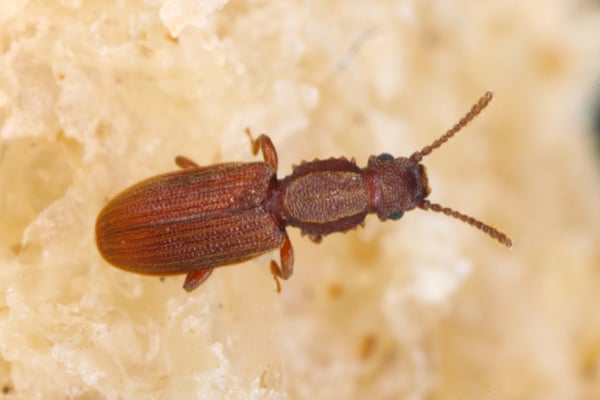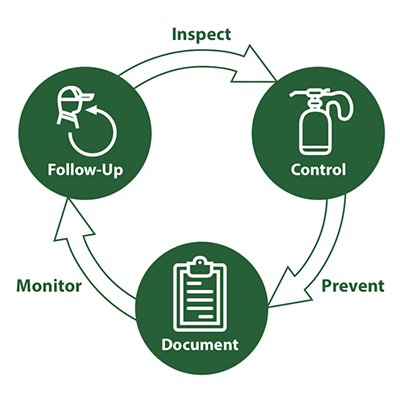Sawtoothed Grain Beetle
Appearance And Behavior
The sawtoothed grain beetle (Oryzaephilus surinamensis) is a very common stored product pest in homes and grocery stores. The name references the 6 saw-like teeth on the beetles’ prothorax (near the head). Sawtoothed grain beetles live all over the world, and they’re quite common in the US and the rest of North America.
Adult Sawtoothed grain beetles are about 1/8" long. Their bodies are brown, dull orange, or dark red in color. They tend to look narrow, flat, and small. All sawtoothed grain beetles have six tiny teeth on each side of their prothorax, just behind their heads. Although adult sawtoothed grain beetles have developed wings, they do not fly.
Sawtoothed grain beetle larva are yellowish-white, elongate, and less than ⅛” long. Grain beetle larvae continuously grow as they eat, so size may vary. Like most beetle larvae, these larvae seem to have distinct body segments.
A sawtoothed grain beetles full life cycle, from egg to adult, may complete in 30 to 50 days. Adults live longer than most beetles. An infestation of sawtoothed grain beetles can reproduce up to seven generations in a single year. If they find a place to stay warm, sawtoothed grain beetles will continue reproducing all year.
Female sawtoothed grain beetle lay 45 to 285 white, shiny eggs in small clusters in crevices in the food material. These eggs hatch in 3 to 17 days depending on the environmental temperature. Larvae molts between 2 to 4 times while growing and eating continuously. When they pupate, larvae construct a cell or cocoon out of food particles held together with oral secretions. After pupating, sawtoothed grain beetle adults may go on to live another 6 to 10 months on average. In optimal conditions, adult beetles have lived longer than 3 years.

The sawtoothed grain beetle does considerable damage to grains, but it cannot attack whole kernels. Instead, they eat crumbs, damaged food, and soft grain products like bread. These beetles use their flat bodies to sneak their way through very small cracks and into imperfectly sealed packages. Adults are not known to fly and are not attracted to light.
Sawtoothed grain beetles attack an extremely wide variety of foodstuffs. Indoors, they’ll feed on cereals, bread, macaroni, dried fruits, nuts, sugar, chocolate, dried meats, tobacco, and many other products. Unsurprisingly, sawtoothed beetles are very commonly found in kitchen pantries.
Sawtoothed Grain Beetle Prevention

The first step toward stopping a sawtoothed grain beetle infestation is preventing them from accessing food sources. Keep all your dry cabinet, pantry, or medicine cabinet materials in airtight, hard plastic containers. Wipe down and clean out dry food storage areas regularly. Prevent crumb accumulation. Look for structural weaknesses that could let beetles into your pantry and seal them up.
Remember: sawtoothed grain beetles can fit through very small cracks. Remove any beetles, larvae, pupae, waste, or shed skin using a vacuum cleaner’s hose attachment. Make sure you throw out the vacuum bag after you use it. Keep a close eye on the food materials you’re bringing into your home. If you notice that food’s packaging is damaged or unsealed, don’t bring it inside!
Sawtoothed Grain Beetle Control Process
Plunkett’s pest management pros start treating for sawtoothed grain beetles by locating areas where they breed. We’ll clean these areas out and help you make sure beetles can’t access them again. We’ll also help clean out infested food and figure out how beetles managed to find that food in the first place.
If need be, we may apply residual insecticide dust to cracks, crevices, structural voids, and other access points. This dust will help repel the beetles after we’ve concluded treatment. In some cases, we’ll also apply insecticide aerosol to stop pest breeding in progress.
If you think you have sawtoothed grain beetles in your building, give Plunkett’s a call right away. We can help identify, locate, wipe out, and exclude your beetles today!

Sawtoothed Grain Beetle Control With Plunkett's
At Plunkett’s, our goal is to help you quickly, conveniently, and in the most cost-effective way. We make every effort to be with you asap, usually within a day or two.
Learn More
There are a good number of stored product pests that are particularly likely to make pests of themselves around your home. Some of the most common examples of stored product pests Plunkett’s encounters frequently include:






